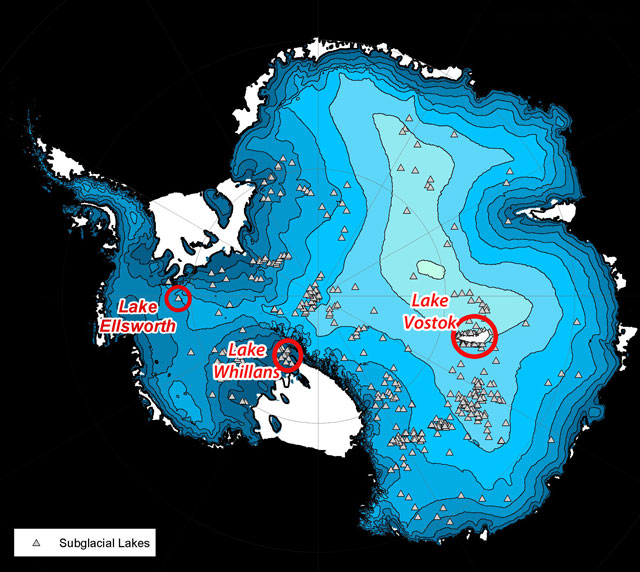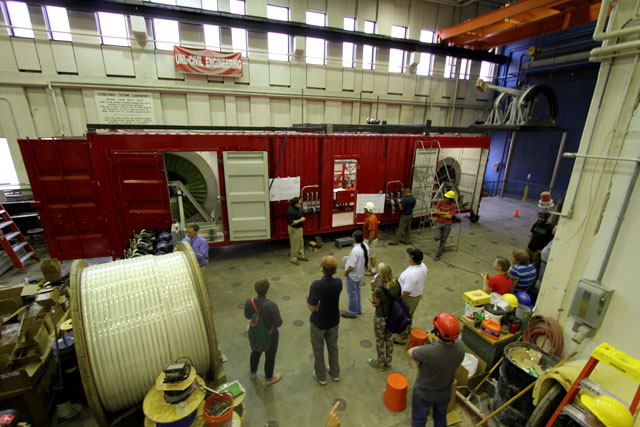|
Page 2/3 - Posted November 9, 2012
Three different environmentsThis year the Russians are expected to sample Lake Vostok properly. Meanwhile, BAS scientists are en route to subglacial Lake Ellsworth Priscu insists that’s not the case, noting that all three lakes are different in nature. For instance, scientists believe both Lake Vostok and Lake Ellsworth are isolated bodies of water, while Whillans is an “active” lake. 
Graphic Credit: British Antarctic Survey and Peter Rejcek
The locations of the three subglacial lakes.
“These are deep lakes without a lot of water coming in and out. The lakes on the Whillans ice plain are very river dominated,” he said. Tulaczyk conceded that the United States didn’t want to be left behind in the realm of subglacial research, but echoed Priscu’s comments about the differences between the three lake systems. For example, Vostok is believed to be ancient, possibly on the scale of millions of years old. Meanwhile, Lake Ellsworth is located in an old, deepened fjord, and has possibly been isolated for hundreds of thousands of years. “Scientifically, they’re really complementary,” he said of three projects. In fact, a Russian scientist has been invited to observe the WISSARD effort this year, and collaborations have been under way with the BAS researchers, according to Priscu. “We’re trying to keep it open,” he said. “We don’t want it to be a race, and I think this is a really good way to keep the spirit of Antarctica in terms of its international aspects.” Language lessonsWhile most of the scientists with WISSARD are American, it doesn’t mean they always speak the same language. A multitude of disciplines is represented within the program, from biologists to glaciologists to geologists. The focus on ensuring that the lake environment remains as pristine as possible — equipment and instruments will be zapped with UV radiation and the drill water treated and filtered to commercial standards — means that the biology is at the forefront of the WISSARD project. That’s a little different from previous projects of this scale, such as the ANDRILL (ANtarctic Geological DRILLing) “The microbiology component is much more important,” Powell said. “It’s been good learning the different ways scientists approach their science.” Tulaczyk agreed that the interdisciplinary nature of the project — mainly supported by the Antarctic Integrated System Sciences (AISS) “We are working together rather than against each other,” he said. “Our scientific goals have always revolved around this idea that water is the substance that connects the glaciology, geology and microbiology, because you need water to support the kind of life we have on Earth.” Life is The ThingAnd what will that life look like? Well, no one is expecting to need flamethrowers, ala the popular The Thing movies. If life exists in these subglacial realms — and most researchers believe they will find evidence — it will be on the microscopic scale, most likely bacteria that have developed strategies to cope in lightless, likely nutrient-poor environments, according to Priscu. “These organisms will be obtaining a lot of their energy from the minerals in the rocks,” Priscu said. “This is what we think we’ll see. This is what we see in Blood Falls, under the Taylor Glacier.” As a graduate student in the Priscu Lab, Jill Mikucki “I think we’ll see a moderately diverse microbial community,” Priscu said. Beyond that? “Who knows?” he responded, noting that it’s possible slightly more complex life may be dwelling in the subglacial ecosystem. Geothermal activity upstream of the Lake Whillans ice plain could support a more energetic and robust environment, he said. “It’s time to go down there and bring a sample to surface and actually look at it,” he said. In hot waterEasier said than done. Much will have to go according to plan in a place that usually doesn’t allow for a large margin of error. Much will depend on the success of the test on the McMurdo Ice Shelf in December. That will be the first trial of the entire system, which features a complex hotwater drill system designed and operated by the University of Nebraska-Lincoln (UNL) “The design and procedures all have to be integrated to make this work seamlessly,” said Frank Rack The new system uses a combination of off-the-shelf components, equipment salvaged from the IceCube Neutrino Observatory The design had to take many factors into consideration, Rack explained. It had to be mobile, as the idea is to traverse, or drive by tractor, much of the equipment to and around the field sites over the course of several years. It had to be integrated with a clean-access system to sanitize the water and equipment that will enter the borehole through which various science instruments will be deployed. And, of course, it had to stand up to Antarctica’s tough environment. “We set out to keep it containerized,” Rack said. “The design is geared toward making it plug and play.”Back 1 2 3 Next |



For USAP Participants |
For The Public |
For Researchers and EducatorsContact UsNational Science FoundationOffice of Polar Programs Geosciences Directorate 2415 Eisenhower Avenue, Suite W7100 Alexandria, VA 22314 Sign up for the NSF Office of Polar Programs newsletter and events. Feedback Form |




